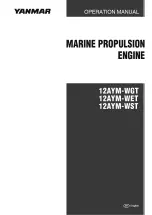
Installation, operation and maintenance instructions
High voltage flameproof motors for explosive atmosphere
AMD Rg 355-400-450-500
Operations prior to commissioning – Electrical operations
Issued by: MOLM
Sheet No.
3AAM101033 E
Rev. B 01.2023
Page 1 of 3
W
e
reserve
a
ll
rights
in
th
is
docu
ment
an
d
in
the
inf
or
mati
o
n
cont
ai
n
e
d
th
er
e
in.
R
epr
o
duct
ion
,
use
of
disc
losur
e
to
thir
d
part
ie
s w
itho
ut
expr
ess
aut
h
or
ity
is
s
tric
tly
for
bidd
en.
CONNECTIONS TO GROUND
Connect to ground with cables having a section
appropriate for the casing, the main terminal box and
all auxiliary equipment, to prevent the external metal
structure reaching hazardous potentials.
Make sure that all ground connections are suitably
identified and marked as required by the applicable
national Standards.
AUXILIARY CIRCUITS
Check the correct connection to all the auxiliary
circuits.
The auxiliary equipment terminals that are usually
live when the machine is not running (e.g. internal
heaters) are to be appropriately identified and
marked.
Warning!
When working on circuits that may be live, take all the
necessary precautions.
ISOLATION RESISTANCE
Before powering a machine for the first time, or after
a long period of inactivity, check the condition of the
stator winding isolation. The isolation resistance
valve of a winding gives indications on the condition
of the winding itself regarding the moisture
absorption and of any dirt that has deposited. If it
does not obtain the minimum level, machine drying
procedures are to be taken into consideration.
Isolation resistance measurement
Measure the isolation resistance before connecting
the power supply cables to the terminals.
Warning!
Before measuring the isolation resistance, make sure
that there is no potentially explosive presence in the
environment.
The isolation resistance measuring instruments
(Megger or similar) apply a steady direct voltage
between the winding being tested and the machine
parts connected to ground; the resistance
measurement is to be carried out one minute after
the voltage is applied. Any parts of the winding not
being tested and the temperature detectors are to be
connected to ground. Usually a three-phase winding
is measured as a whole, but if the centre star
connection can be opened, the test can be made
phase by phase. For safety reasons, after the
application of the voltage, the tested winding is to be
immediately connected to ground.
The test voltage value, according to the instrument
used, is usually between 500 and 2500 Volts. Follow
these general criteria:
a) For low voltage machines, the test voltage
is not to be more than 500 Volt.
b) Test voltages between 500 and 2500 Volts
in practice produce the same isolation
resistance values
It is therefore advised to normally use a voltage of
500 Volts.
Phase by phase measurement
U V W
R
isolam
measuring instrument (Megger type) 500 Volts d.c.
Complete winding measurement
U V W
R
isolam
measuring instrument (Megger type) 500 Volts d.c.
Minimum permissible values of isolation
resistance
For the motor power supply, taking only into
consideration the safety of the operators, the
minimum permissible value of the stator winding
isolation resistance is the following:
R
1min
(20°C) =
3 x (1 + Un)
M
Un =nominal voltage of the motor in kV (line to line).
The value refers to the complete winding.
Measuring one phase only the minimum permissible
value with be roughly double.
In spite of this, the expected value for new windings
and proposed by good start-up workmanship is
R
1min
(20°C) >
30 x (1 + Un)
M
The isolation resistance largely depends on the
temperature of the winding; the values below refer to
a
temperature of 20°C
.
A temperature increase of 10°C halves the isolation
resistance value and vice-versa. For example, if a
winding at 40°C has a resistance of 20 M
, this
corresponds to 80M
at 20°C. This latter value is to
be compared with the minimum permissible value.
















































